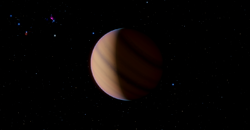Astronomy:Pollux b
 Pollux b | |
| Discovery | |
|---|---|
| Discovered by | Hatzes et al. |
| Discovery site | United States |
| Discovery date | 16 June 2006 |
| Radial velocity | |
| Orbital characteristics | |
| 1.64 ± 0.27 AU (245 ± 40 million km) | |
| Eccentricity | 0.02 ± 0.03 |
| Orbital period | 589.64 ± 0.81 d 1.61432 ± 0.00222 y |
| astron|astron|helion}} | 2,447,739.02 ± 4.5 |
| Semi-amplitude | 41.0 ± 1.6 |
| Star | Pollux |
Pollux b, also designated β Geminorum b (Latinized to Beta Geminorum b, abbreviated, β Gem b) and HD 62509 b, formally named Thestias /ˈθɛstiəs/, is an extrasolar planet approximately 34 light-years away in the constellation of Gemini (the Twins). This planet was discovered orbiting the star Pollux in 2006 by astronomer Artie P. Hatzes, confirming his hypothesis originally published in 1993. The planet has at least twice the mass of Jupiter. It moves around Pollux in 1.61 years at a distance of 1.64 astronomical unit|AU in a nearly circular orbit.
Naming
In July 2014 the International Astronomical Union launched NameExoWorlds, a process for giving proper names to certain exoplanets and their host stars.[1] The process involved public nomination and voting for the new names.[2] In December 2015, the IAU announced the winning name was Thestias for this planet.[3] The winning name was based on that originally submitted by theSkyNet of Australia ; namely Leda, Pollux's mother in Greek and Roman mythology. At the request of the IAU, 'Thestias' (the patronym of Leda, a daughter of Thestius) was substituted. This was because 'Leda' was already attributed to an asteroid and to one of Jupiter's satellites.[4][5]
See also
- Gemini in Chinese astronomy
- Cancer Minor (constellation) – Obsolete constellation inside modern Gemini
- Sudarsky's gas giant classification
References
- ↑ NameExoWorlds: An IAU Worldwide Contest to Name Exoplanets and their Host Stars. IAU.org. 9 July 2014
- ↑ "NameExoWorlds The Process". http://nameexoworlds.iau.org/process.
- ↑ Final Results of NameExoWorlds Public Vote Released, International Astronomical Union, 15 December 2015.
- ↑ "NameExoWorlds The Approved Names". http://nameexoworlds.iau.org/names.
- ↑ YOU helped name an exoplanet! , TheSkyNet, 2015-12-17
- A. P. Hatzes (1993). "Long-period radial velocity variations in three K giants". The Astrophysical Journal 413: 339–348. doi:10.1086/173002. Bibcode: 1993ApJ...413..339H.
- A. P. Hatzes (2006). "Confirmation of the planet hypothesis for the long-period radial velocity variations of β Geminorum". Astronomy and Astrophysics 457 (1): 335–341. doi:10.1051/0004-6361:20065445. Bibcode: 2006A&A...457..335H.
- S. Reffert (2006). "Precise Radial Velocities of Giant Stars. II. Pollux and Its Planetary Companion". The Astrophysical Journal 652 (1): 661–665. doi:10.1086/507516. Bibcode: 2006ApJ...652..661R.
External links
- Hatzes (2006-06-16). "Confirmation of the Planet Hypothesis of the Long-period Radial velocity Variations of β Geminorum". European Southern Observatory. http://exoplanet.eu/papers/bgempaper.pdf.
- "Pollux". SolStation. http://www.solstation.com/stars2/pollux.htm.
- Sabine Reffert et al. (2006-07-07). "Precise Radial Velocities of Giant Stars II. Pollux and its Planetary Companion". Astrophysical Journal 652 (1): 661–665. doi:10.1086/507516. Bibcode: 2006ApJ...652..661R.
Coordinates: ![]() 07h 45m 19.4s, +28° 01′ 35″
07h 45m 19.4s, +28° 01′ 35″
 |

